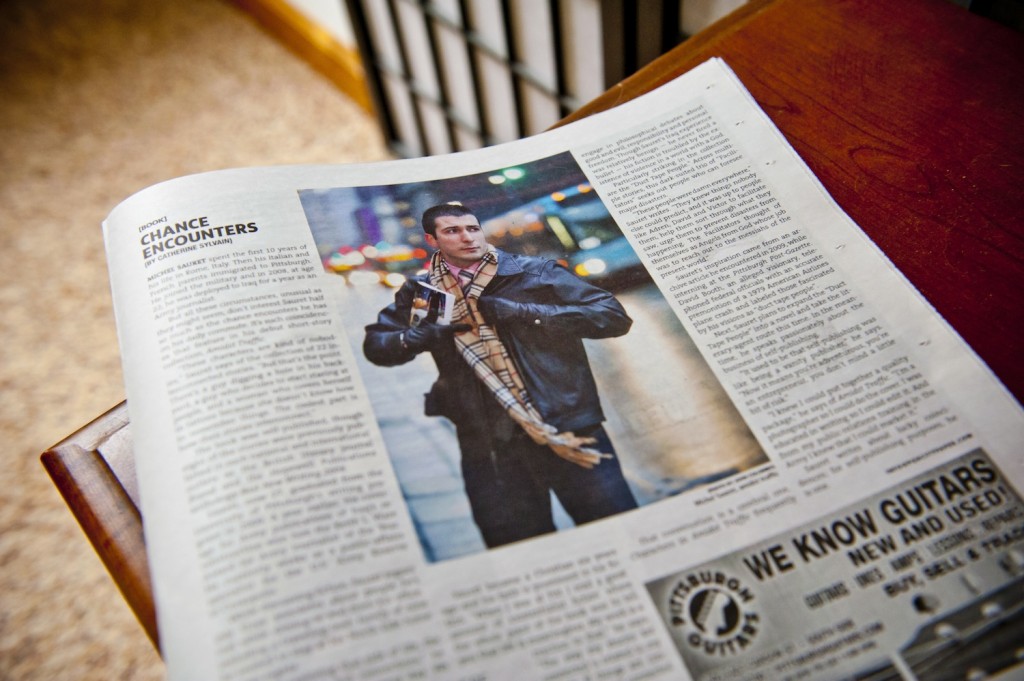(This article was first published by Blogging Authors)
A few weeks ago, the Pittsburgh City Paper featured my book Amidst Traffic both in their paper and online. I achieved this for free by crafting a quality press release, requiring only a bit of knowledge and time.
When I first published Amidst Traffic, I was surprised by how many sites charged good money to write press releases on behalf of published authors. Their prices weren’t cheap either, usually several hundred bucks. I thought this was strange: that an author might pay someone else to write a one-page letter.
After all, if you just finished writing a novel, how difficult could it be to write a press release?
It’s not very difficult…
But there are journalistic rules you must follow to make the release look professional.
Fortunately, I’ve worked as an Army journalist and public affairs specialist for eight years, so I knew the rules. Here, I wanted to share some tips with other authors who might benefit from them.
First: Build Your Distribution List
Your press release will do you no good if you don’t have any recipients. Start building your list now and continue to add contacts gradually. Some websites will sell you a list of news contacts according to your needs. This is an expense (usually $300 or more) you can save by doing a bit of research. Most websites will have editors’ email addresses right on their websites. With a bit of searching and a day’s worth of work, you can accumulate several hundred relevant contacts.
Make sure you don’t blast every editor. Target your release to those editors who might actually be interested in your book (A&E editors for example). Otherwise you’ll just annoy the editorial staff.
Select a Delivery Platform
I used Gmail to send my first two releases, but then I realized I couldn’t track who opened the message and if anyone even clicked on the links I sent out. Soon, I switched to Mail Chimp, which allows you to build a distribution list, create “campaigns” and replicate them (and resend them) with ease. Mail Chimp will tell you exactly who opened your email, who didn’t, and which link they clicked on!
You can even schedule your press release for a specific time and date. It’s awesome, and it’s FREE. You can add your mailing list manually, and recipients can unsubscribe if they feel your material isn’t pertinent to them.
General Rules of Writing Your Release
To give you a reference, I’ve included a sample release I sent out recently, which you can download here. For the most part, study the formatting and writing style used in the sample, and you will be able to create your own release easily.
Most journalists and newspapers use the AP Stylebook to format their articles. You can pick up a used copy for just a few bucks, which will prove extremely helpful. I’ll try to hit some of the main rules to keep in mind below.
Also, don’t include attachments. Keep your release in the body of the email. If you use Mail Chimp, you’ll be able to embed images in the release itself without attachments.
Most editors will delete emails with attachments.
Headline
Write your headline in sentence case; this means capitalize only the first word and proper nouns.
Write your headline in active voice (“Author publishes book” instead of the passive “Book is published by author”) and in a straightforward manner. Also, write headlines in the present tense, even if something happened in the past (“Author releases debut novel” rather than “Author released novel”). If you’re announcing the release an upcoming book, the headline would read “Author to release novel” and not “Author will release novel.”
The headline to the sample press release I provided, “Book by award-winning Army journalist makes Editor’s Choice selection” is longer than what I usually like, but it holds enough of a hook (the fact that I’m an award-winning Army journalist and that my book was selected for Editor’s Choice) to justify its length.
You can find more helpful rules for headlines here.
News Lead
Your lead (first paragraph) needs to be one sentence and should establish several things at once: catch the reader’s attention, summarize what the press release is about and be concise. Your news lead should hold a “hook” that proves interesting to news editors (highlight an award you’ve won or tie in your book in a way that’s relevant to current events or big news stories).
Start your lead with the dateline, which is the name of the city and state where the press release is coming from. You can omit the state if the city is well known.
Your lead needs to be one sentence and answer the five Ws (Who, What, Where, When and Why). The “Why” is not always answered in the lead, but if it’s relevant you can include it.
Here’s my news lead as an example:
PITTSBURGH (dateline) – Independent Publisher (who) selected Amidst Traffic (what) as an Editor’s Choice Highlighted Title this month (when) from hundreds of submitted entries.
In this case, since Independent Publisher is a website, the “where” is omitted and the “why” is answered later in the release.
Bridge
The bridge is the second sentence and it should either address the “why” or provide other relevant information. In my case, I decided to highlight the fact that I’m an award-winning Army journalist and mention that the book was released in November.
The Rest of the Story
Keep your writing active and your sentences direct throughout the release. Your entire release should be less than one page. The goal is NOT to tell editors all about you, but entice them enough to want to learn more.
General AP Style Rules…
You can find essential rules from the AP Stylebook here, but below are some of the more important rules to keep in mind.
Third person – Write the entire release in third person. If you published your book using a registered publisher’s name, use that to represent the book. For example, I’ve used the name One Way Street Production to serve as my book publisher. When using my publisher’s name, I would say, “One Way Street Production released a new collection of short stories” rather than “Michel Sauret released…” This gives the article more authority. Always refer to yourself in the third person.
Past tense – Write the whole release in the past tense. Period. This contradicts the headline tense, but that’s the rule. Follow it. (The only exception is for things happening in the future, of course)
Second reference – Use just your last name when referring to yourself after the first reference. “Michel Sauret” the first time, but only “Sauret” after that.
Numbers – Numbers one through nine are spelled out, and anything from 10 and after is written in numerals.
State abbreviations – States are spelled out in full unless used with a city. If you have a city and state, the state is abbreviated differently than your typical two-letter capitalized abbreviation (Pa. instead of PA, Tenn. instead of TN and so on). Your best bet is to look here for proper use of states.
Dates – Months are spelled in full except when used with a specific date, and you never use 1st, 2nd, 3rd or so on for dates (Jan. 1 instead of Jan. 1st). Don’t include a year unless it’s more than 12 months ago or 12 months from now.
Titles – The AP Stylebook says to use quotation marks around book titles, but I’ve seen news articles italicize titles without quotations. Pick one style and stick with it throughout the press release.
Spend some time familiarizing yourself with an AP Stylebook and reference to it constantly as you write and review your press release before sending it!
The Follow Up
In regards to the follow up, I will quote material from an article by Joan Stewart of the Publicity Hound, because her answer is succinct and helpful:
When following up, remember The Rule of 7. That means you should follow up seven times, using a combination of phone calls and emails, before you stop contacting journalists. But always be ready in case they call you.
Never follow up on routine press releases announcing things like promotions or awards you’ve won, or they’ll view you as a pest. Your efforts are better spent following up on larger stories you have pitched.
When following up, concentrate on benefits. Explain how the idea you are pitching is the solution to a problem–and do it quickly, in fewer than 30 seconds.
When you call or email, don’t say, “Did you get my press release?” or “I’m following up on a call I made two weeks ago.” Jill says: “I typically will say, ‘I sent you some information.’ That’s my code word for press release. What I have found when talking to the media is they hate when you call them up and say, ‘Did you get the press release?’ What they love is for you to talk about the information in terms of how it can be readily used by them, and why they would care. Really. That’s the bottom line. Why would they care?”
When following up, never, ever ask a reporter to alert you when the story is printed, or to send you a certain number of reprints of the article. It’s your job to monitor the publications, then call the circulation department and order however many copies you want. Expect to pay for them.
Be Ready and Be Patient
If you do receive interest in your book, be prepared to meet with the assigned reporter quickly, since they’ll be working on a deadline. Once your interview is over with the reporter, don’t hound them and don’t keep pestering them with multiple emails. Show some grace and gratitude. Definitely show thanks and appreciation, but NEVER demand or ask to see the article before it’s published. You’ll create nothing but distaste in their mouth.
Not every release is going to entice a bite. Keep tweaking your release and stay active so that you can keep your book relevant and newsworthy. Don’t simply rehash and resend the same press release over and over again. Update it every time with new information before resending it.
 Michel Sauret – Award-Winning Army Journalist | Independent Author Award-Winning Army Journalist, Independent Author
Michel Sauret – Award-Winning Army Journalist | Independent Author Award-Winning Army Journalist, Independent Author







Thank you so much for this. I’m a writer coming from Plaisir, France and what I just read here on msauret.com could not be said much better. Reading through this article kinda reminds me of my old roomie, Kellee. He incessantly kept preaching about this. I most certainly will send this information to him. I’m certain he will have a good time reading this.
I appreciate you for posting this.